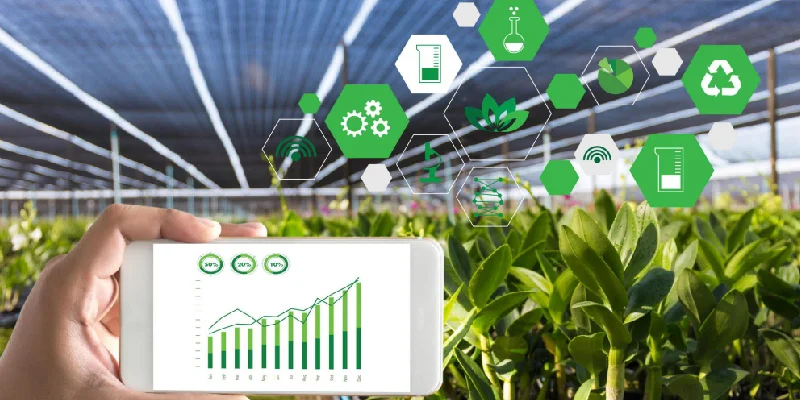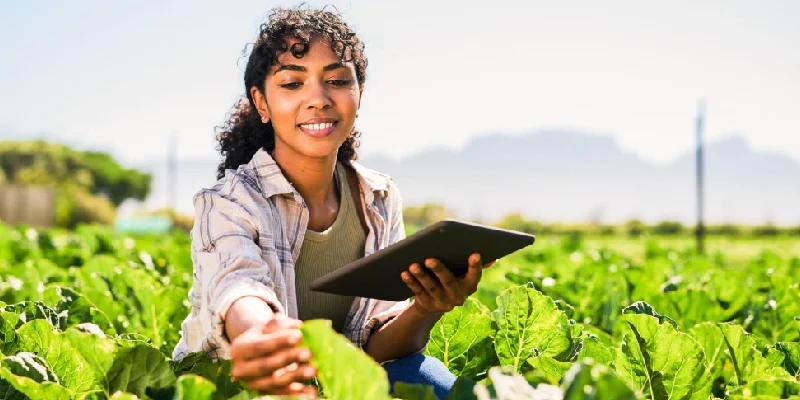Agriculture and Farming Audit Procedure, Challenges, Best Practices, and Its Checklist

January 18 , 2024
It is essential to check agricultural products to ensure they are safe and of good quality and that all animal and chemical usage management is implemented correctly. To ensure all standards are met, and risks are kept to a minimum, proper audit planning is necessary to pay close attention to every detail. Because of this, a thorough agricultural inspection helps ensure that farmers, processors, manufacturers, and retailers follow the rules set by the government, accelerate workflows, and meet customer expectations.
This piece talks about the importance of agriculture inspections, common challenges faced, and the best practices to perform inspections that don’t harm the environment, like for sustainability.
Find out why the UrAudits inspection app is the best way to digitize farm audits and bring about a new era of efficiency and compliance in the field.
What is agriculture and farm auditing?

Agriculture and farm auditing are methodical ways to examine different parts of farming, like planting and rotating crops, watering, managing and refining soil nutrients, getting rid of pests, and raising animals. These audits integrate careful checks and studies to ensure that a farm’s operations adhere to rules and standards and that the farm’s financial statements are accurate.
Farm checks are a significant part of preserving agriculture’s openness and honesty. They help you receive accurate data about elevating effectiveness, protecting the environment, adhering to the law, following FSMA 204, and using sustainable farming techniques, such as permaculture, natural farming, and hydroponics.
By working toward these goals, farm audits make a big distinction in the progress of the agricultural sector.
Three critical farming and agricultural processes
There are different ways that agriculture inspection. Sometimes, inspectors perform these at checkpoints alongside the road, where trucks and their loads of agricultural goods are checked before they join a particular area, keeping away pests and other threats to the farming company. There are also inspections at shipping ports, farms, and places that oversee food or meat. Agricultural inspectors keep an eye on the following places and processes during these checks:
Livestock production
Breeding, expanding, and killing animals for their meat are all part of this farming approach. It has multiple steps, like being beneficial for animals, managing feed, preserving animals’ health, and humanely treating animals.
It is significant to the world’s food supply because it gives millions of audience members the protein and calories they crave. There are strict rules To ensure the safety and excellence of meat products and instructions about how to care for animals, keep things clean, and prevent diseases.
Chemical hazards
Chemicals like fertilizers, pesticides, and herbicides can help farmers grow more crops and keep plants healthy by killing pests and diseases. However, misusing these poisons or in too great an amount can harm the audience, the environment, and farming.
Managing chemical risks means choosing, using, storing, and disposing of chemicals in a way that causes the least amount of harm. Farmers and others who work in agriculture must adhere to specific rules and laws to prevent chemicals from entering the soil, water, and crops and to protect the wellness of consumers, workers, and ecosystems nearby.
Facilities and equipment
For farming to be practical and sustainable, it’s essential to keep agricultural buildings and tools in good shape and oversee them well, including developing plans for, constructing, and operating factories, warehouses, and processing plants and using and maintaining tools and machines.
Keeping buildings and machines protected and working well can help reduce waste, stop disease, and maximize asset use. Following rules and laws about buildings and tools also helps create a safe place to work, improves the quality of items, and makes agriculture more environmentally friendly.
Challenges in Agriculture and Farm Auditing

Now, let’s talk about workers’ challenges in the sector.
- Absence of peer record management – Because the world’s population is expanding, agriculture is becoming increasingly important to meet people’s core demands. Still, the farming sector doesn’t have enough continuous record preservation to keep up with the expanding demand for food.
- Not enough data integration. Norm inspection data is frequently stored in separate files and is difficult to analyze, which makes it challenging to spot trends and keep track of progress.
- Crop rotation – Crop rotation is a big part of crop productivity. Not following the correct rules can harm the land and change the biochemical traits of the soil.
- Food safety and traceability – The audience desires food to be more open, and they are challenging it. It is vital to be capable of looking out (for) food from the farm to the table to ensure it is protected, stop food fraud, and keep clients trusting the food distribution chain.
- Infrastructure system – Farmers cannot exalt their output and keep up with the latest technologies without access to sound watering systems and modern farming tools.
- Climate Hurdles: Dealing with the issues caused by climate change – The manufacturing revolution has lifted temperatures around the globe by producing more greenhouse gases. It’s not always clear when it rains, and it happens more frequently than usual.
- Time Issue – hand needs to perform this and takes a lot of time – traditional checks include going to farms in person, which can take a lot of time and work.
- Wrong feed data – finding out the usage of feed quantity is significant for farming achievement and operating a company effectively. Mistakes created by the audience under stress can cause harm.
- Limited coverage – because of limited assets, inspectors can only visit a few farms at a time, which means that data is incomplete and there may be holes in compliance.
- Subjectivity and inconsistencies – different inspections may have different ideas about how the rules ought to be followed, which can lead to inconsistent outcomes and unfair treatment of farmers.
Best Methods To Have A Sustainable Farming And Agriculture Plan
Now, let’s go through some standard farm auditing processes for eco-friendliness.
Maintaining soil fertility
Ensure the soil persists and is fertile and productive over time. Analyze the soil in particular fields frequently to track changes and maintain fertility.
Maintaining a closed system
Limit external inputs and outputs to keep the farm self-sufficient. Calculate the percentage of nutrients carried onto the farm associated with exports. Measure the percentage of feed carried in versus what the animals consume and assess the farm’s manure strategy and how well it is controlled.
Livestock management
Examine the herd’s average age to guarantee healthy and effective livestock management. Track wellness indicators like mastitis incidence and medicine costs. And imagine other factors, like the distance to slaughter.
Avoidance of pollution
Prevent environmental pollution from farm actions by determining the danger of nitrate leaching from the soil. Examine risks joined with ammonia and methane emissions. Recognize and oversee excessively high-rise phosphate levels in the soil. And track and quantify pesticide use and farm waste.
Food production
Produce high-quality food effectively by measuring energy output per unit of land. And examine food excellence through sales data.
Non-renewable resource
Effectively use assets and integrate renewable sources. Assess energy use associated with energy output. Recognize and use renewable energy sources. And track water sourcing, recycling, and effectiveness.
Decentralization
Collecting data on the distance inputs (resources) and items travel can minimize this distance.
Social function
To promote social responsibility and community interaction, you can determine the farm’s profitability, track the number of labor units per unit of land, and examine staff training and community interaction.
Use of the right technology
Use technology wisely, like the UrAudits inspector app, for effective and sustainable methods. Observe and determine whether the right or inappropriate technologies you go for.
Biodiversity and landscape
You can maintain biodiversity and health by executing and following a conservation strategy. You can track the existence of particular bird species. And examine diversity in crops and livestock.
What is an agriculture/farming inspection checklist?
An agriculture inspection checklist outlines the places and items that must be inspected to ensure compliance with agriculture regulations. It can integrate questions about the safety of food, facilities, and equipment, the well-being of animals, chemical hazards, and other hindrances related to farming.
Inspectors need to know their job and its extent when they conduct an inspection. The farm inspection checklist should be complete and particular, listing the steps needed at each inspection stage. It is crucial to update the checklist frequently to ensure compliance with the latest regulations and industry standards.
Who utilizes an agriculture/farming inspection checklist?

Multiple audiences and teams in the agricultural sector use a farm inspection checklist to ensure they adhere to the rules, keep safety standards high-rise, and spread the great methods. Specific expected audiences who use a farm inspection checklist are;
- Authority inspectors: Checklists are frequently used by authority officials in charge of food safety, animal care, and environmental laws when they visit farms, processing plants, and other agricultural companies to carry out inspections and audits.
- Companies that prepare and make food: Companies that prepare and make food from agricultural items can use checklists to ensure their suppliers adhere to safety and excellence standards and to check the excellence of their facilities, tools, and processes.
- Farmers and producers: checklists can be used by farm owners, operators, and managers to help them figure out what must be stable, ensure they follow the rules, and put great methods into their operations. Regular self-inspections can help stop issues before they worsen and ensure that farm items are protected and of good excellence.
- Agricultural consultants: these are the people who help and give guidance to farmers and agricultural companies. They may use checklists to look at operations, discover possible risks or areas for improvement, and then suggest ways to make things safer, more productive, and ultimately longer-lasting.
- Third-party auditors are impartial teams or certifying bodies that check suppliers against specific excellence, safety, or eco-friendliness standards on behalf of clients like food processors or stores. These inspectors use checklists to ensure that their reviews of farming operations are regular and complete.
Using an agriculture inspection checklist, these teams can go above different parts of farming operations in a planned way.m confirms that follow-up of rules, safety, and quality standards are kept, and sustainable farming techniques are encouraged.
What can you add to an agriculture inspection checklist?
An agriculture inspection strategy ought to cover multiple regions of farming to ensure that rules are followed, excellence and safety standards are kept, and environmentally gracious techniques are encouraged. Here are certain significant things that ought to be on a checklist for an agricultural inspection:
- General farm information: this includes where the farm is located, how big it is, who owns it, what kinds of crops or animals are lifted there, and how to get in touch with the farm.
- Record-keeping and documentation: checking that primary records are kept, like food safety plans, chemical application logs, and records of animal wellness.
- Worker safety and hygiene: evaluating worker training, personal protective equipment (PPE), toilets, initial help supplies, and emergency plans.
- Animal welfare and husbandry: checking the housing, food and water, veterinary care, managing, and movement of animals to ensure that they get humane treatment and that no diseases enter their body
- Crop creation and protection: checking planting, watering, fertilizing, pest control, and harvesting techniques, as well as crop management techniques, to make sure they adhere to the rules and decrease risks.
- Chemical storage and handling: a look at how to store, name, use, and get rid of chemicals like fertilizers, pesticides, and herbicides correctly to keep the audience and the environment protected for everyone.
- Soil and water management: an analysis of how to protect the soil, stop erosion, and use water in a way that helps eco-friendliness and keeps the agricultural environment healthy.
- Facilities and equipment: checking buildings, storage regions, processing plants, and machines for safety, cleanliness, and proper upkeep.
- Waste management: in search of how to get rid of trash, like manure and sludge, in a way that doesn’t pollute and harm the environment.
- Food safety and quality: checking the managing, storage, and shipping of agricultural items after they are harvested to ensure they are protected and of good excellence.
Why is the UrAudits inspection app best for performing digital farming and agriculture auditing?

UrAudits audit app is the best option for digitizing farm audits, which will significantly improve compliance and efficiency in the field. This all-in-one inspection app, also called the audit project management app, solves the problems that come up with traditional farm audits and makes methods more environmentally friendly.
The UrAudits agriculture audit app streamlines operations, enabling farmers to manage produce, machinery, and tools efficiently. Digital audits save time and money by not using paper and giving real-time results and dashboards for quick insights. An easy-to-use interface, real-time data, and digital audit template can make inspection easy in the sector.
With features like energy and agriculture integration, the UrAudits Android auditor app facilitates efficient mobile inspections, enabling users to carry customized checklists wherever they go. Real-time reports help farmers keep track of their tasks and make choices based on data, encouraging them to follow the strictest rules.
UrAudits does a great job of collecting and analyzing data, which lets user’s spot trends and take action. The platform has many ready-made checklists and audit templates for reviewing farms, packing houses, storage, shipping, and other areas of agriculture. It ensures that all of these areas are thoroughly inspected.
The UrAudits auditing app is cloud-based, allowing for infinite media attachments and safe geo-fencing. The platform also provides site audit reports to help with strategic decisions, and the executive dashboard gives C-level executives a complete picture of the company.
Conclusion
Visit our website to explore the UrAudits audit and team management apps. An auditing app for iOS, an auditor app for Android, and a web app are available.
Copyright © 2024 Uraudits.com. All Rights Reserved. Privacy Policy | Legal | Terms of Use
Privacy Overview
| Cookie | Duration | Description |
|---|---|---|
| cookielawinfo-checbox-analytics | 11 months | This cookie is set by GDPR Cookie Consent plugin. The cookie is used to store the user consent for the cookies in the category "Analytics". |
| cookielawinfo-checbox-functional | 11 months | The cookie is set by GDPR cookie consent to record the user consent for the cookies in the category "Functional". |
| cookielawinfo-checbox-others | 11 months | This cookie is set by GDPR Cookie Consent plugin. The cookie is used to store the user consent for the cookies in the category "Other. |
| cookielawinfo-checkbox-necessary | 11 months | This cookie is set by GDPR Cookie Consent plugin. The cookies is used to store the user consent for the cookies in the category "Necessary". |
| cookielawinfo-checkbox-performance | 11 months | This cookie is set by GDPR Cookie Consent plugin. The cookie is used to store the user consent for the cookies in the category "Performance". |
| viewed_cookie_policy | 11 months | The cookie is set by the GDPR Cookie Consent plugin and is used to store whether or not user has consented to the use of cookies. It does not store any personal data. |









